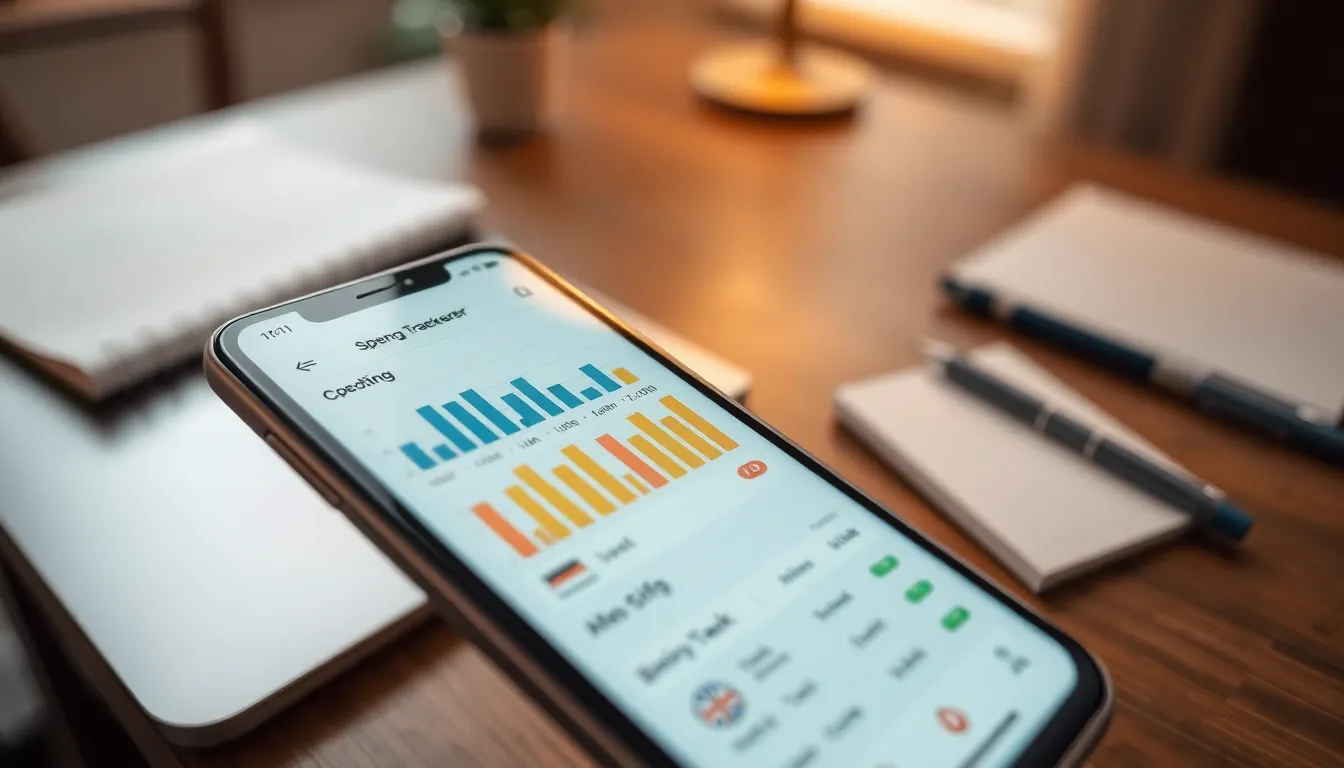In a world where coffee costs more than a small car and takeout seems to multiply overnight, keeping tabs on spending can feel like herding cats. Enter the spending tracker, your trusty sidekick in the epic quest for financial sanity. It’s like having a personal accountant in your pocket—minus the awkward small talk and the need for a tie.
With a spending tracker, you’ll finally uncover the mysterious whereabouts of your hard-earned cash. Is that daily latte really worth the price of a gym membership? Spoiler alert: it probably isn’t. By harnessing the power of a spending tracker, you’ll not only regain control over your finances but also discover the joy of budgeting—yes, joy! So buckle up and get ready to embark on a money-saving adventure that’ll leave your wallet happy and your bank account thriving.
Table of Contents
ToggleOverview of Spending Tracker
A spending tracker serves as an effective tool for individuals aiming to manage their personal finances. It allows users to log daily expenditures, uncover spending patterns, and make informed financial decisions. With a simple interface, many spending trackers categorize expenses automatically, making it easier to monitor where money goes each month.
Users often find it beneficial to visualize their spending habits through charts and graphs. Seeing patterns can highlight unnecessary expenses, enabling users to reduce costs. Tracking small daily purchases, such as coffee or snacks, reveals how quickly these costs accumulate over time.
Furthermore, spending trackers facilitate budgeting by establishing limits for various categories, such as dining out or entertainment. By setting these limits, users practice discipline in their financial choices. Some apps even send notifications when spending nears these predefined limits, providing reminders to stay on track.
Many spending trackers offer features for linking bank accounts and credit cards, allowing for automatic updates in real time. By having instant access to their current financial situation, users can make immediate adjustments when needed. Data security remains a priority with most platforms, ensuring that personal information remains protected during this process.
Ultimately, a spending tracker helps individuals take control of their finances. Whether through dedicated applications or spreadsheets, it provides valuable insights into spending habits, promoting better financial health and awareness. Users who regularly engage with these tools often experience reduced financial stress, leading to more enjoyable budgeting.
Key Features of Spending Trackers

Spending trackers come with essential features that enhance financial management. Each aspect contributes to a user’s ability to monitor and control their finances effectively.
Budgeting Tools
Budgeting tools within spending trackers provide real-time insights into spending habits. Users can allocate specific amounts to categories such as groceries, dining, and entertainment. Setting limits keeps spending in check and encourages mindful financial choices. Some trackers allow users to adjust budgets quickly based on spending patterns. Alerts send notifications when approaching budget limits, supporting disciplined financial behavior. Effective budget management builds a strong foundation for financial health.
Expense Categories
Expense categories categorize spending automatically, simplifying tracking. Users can easily visualize where money goes each month. Standard categories often include housing, transportation, and food, but customization options exist for individual needs. Users benefit from identifying high expense categories, enabling them to cut unnecessary costs. This feature fosters awareness and encourages smarter spending decisions. Options for color-coding categories enhance user experience further.
Reporting and Analytics
Reporting and analytics features in spending trackers empower users to analyze their financial data. Comprehensive reports show spending trends over time, helping users understand their financial behaviors. Graphs and charts provide visual representation, making complex data easy to digest. Users can generate specific reports for short or long-term periods to assess financial goals. Identifying patterns enables informed decision-making, ultimately leading to improved financial outcomes. Regular analysis promotes a proactive approach to managing finances.
Benefits of Using a Spending Tracker
Utilizing a spending tracker offers numerous advantages that contribute to financial stability. Improved financial awareness and enhanced budget management stand out as key benefits.
Improved Financial Awareness
Spending trackers provide real-time insights into expenditures. Users gain clarity on where their money goes, allowing them to identify patterns in spending. For example, noticing frequent purchases of takeout helps pinpoint areas for cost reduction. Increased awareness fosters better decision-making regarding unnecessary expenses. Many trackers also include visual representations of spending habits, which facilitate comprehension of financial behavior. This enhanced understanding promotes discipline, leading to healthier financial choices.
Enhanced Budget Management
Effective budget management becomes achievable with a spending tracker. Users can allocate specific amounts for various categories, such as groceries and entertainment. Automatic notifications alert them when they approach or exceed set limits, reinforcing mindful spending. Flexibility in adjusting budgets ensures alignment with changing financial circumstances. Graphs and reports generated by the tracker simplify the assessment of overall financial health. Clear visibility of monthly expenses empowers individuals to make informed decisions. Ultimately, this structured approach enhances financial discipline and promotes long-term savings.
Popular Spending Tracker Apps
Spending tracker apps offer valuable features that help manage finances effectively. Users can choose from several options, each with unique strengths.
App Comparison
YNAB focuses on zero-based budgeting, encouraging users to assign every dollar a purpose. Mint excels in providing a comprehensive overview of financial health, automatically importing transactions. PocketGuard simplifies budgeting by showing how much disposable income is available after expenses, bills, and goals. Personal Capital emphasizes investment tracking alongside budgeting, catering to those looking to grow wealth. Each app provides different insights, allowing users to select one that aligns with specific financial goals.
User Experiences
Many users praise YNAB for its structured budgeting approach, noting it drastically improves financial awareness. Mint’s automatic categorization receives positive feedback, making it easy for users to track spending without manual entry. PocketGuard’s simplicity helps users feel less overwhelmed, appealing especially to those new to budgeting. Personal Capital gets recognition for offering robust investment features, often seen as beneficial for long-term planning. User testimonials highlight how these apps can transform financial habits and lead to better financial stability.
Tips for Choosing the Right Spending Tracker
Finding the right spending tracker aligns with individual financial goals and preferences. Identifying specific needs significantly impacts the selection process.
Assessing Your Needs
Evaluate features that align with personal financial strategies. Users might prioritize budget management, expense tracking, or visual reporting. Consider programs that provide real-time insights into spending patterns and automatic categorization of expenses. A user-friendly interface enhances the overall experience, as it simplifies daily logging. Determine whether alerts for budget limits are essential, fostering responsible spending. Focus on compatibility with financial goals, ensuring a long-term fit.
Integration with Other Financial Tools
Compatibility with existing financial tools can streamline money management. Assess spending trackers that seamlessly connect with bank accounts and credit cards for real-time updates. Users benefit from tools that integrate budgeting apps or investment platforms, providing a holistic view of finances. Consider those that offer robust reporting and analytics features, helping analyze financial data comprehensively. Effective integration enhances decision-making by easily visualizing total financial health. Prioritizing these aspects makes it simpler to maintain organized, efficient financial management.
Embracing a spending tracker can significantly enhance financial management and awareness. By identifying spending patterns and setting budget limits individuals can make informed decisions that lead to healthier financial habits. The convenience of real-time updates and automatic categorization simplifies tracking while offering valuable insights into monthly expenses.
Choosing the right spending tracker tailored to personal financial goals can further streamline the budgeting process. With the right tools individuals can take control of their finances reduce stress and pave the way for a more secure financial future. Investing time in a spending tracker is a step toward achieving financial stability and peace of mind.



